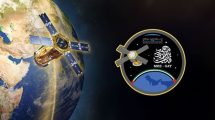 There is a cumulative market opportunity of $18.4 billion over the next decade for satellite-based big data analytics, according to NSR’s Big Data Analytics via Satellite, 3rd Edition. Alongside more traditional applications in the energy, transportation, civil government & military sectors, prime amongst today’s fastest growing verticals is the Services sector, commented NSR analyst Shivaprakash Muruganandham in a report.
There is a cumulative market opportunity of $18.4 billion over the next decade for satellite-based big data analytics, according to NSR’s Big Data Analytics via Satellite, 3rd Edition. Alongside more traditional applications in the energy, transportation, civil government & military sectors, prime amongst today’s fastest growing verticals is the Services sector, commented NSR analyst Shivaprakash Muruganandham in a report.
“The Services vertical mainly consists of financial institutions involved in the securitization of commodities and hedge funds, where large risks are at play. While it took up only about 7% of the market share as of 2018, it is expected to rapidly grow through the next decade to reach nearly $640 million (20% market share) in revenue opportunity by 2028,” he stated.
He reported that a majority of this growth is attributed to the proliferation of EO-based analytics in recent years.
“Investment firms looking to gain a competitive edge on the market have driven the use of satellite data across the board: from the counting of cars in parking lots and oil barrels to derived vegetation metrics for crop yield and carbon stocks. Firms such as Ursa Space, Rezatec and Orbital Insight help investors pick the right commodities.
“Financial products built on monitoring economic activity already abound in the market: including notable ones such as SpaceKnow’s China Satellite Manufacturing Index that tracks manufacturing activity in China, or RS Metrics’ MetalSignals, which predicts price and inventory movements on the London Metals Exchange.”
His report went on to add that the nature of the Banking, Financial Services and Insurance (BFSI) sector offers “ample crossover in applications with verticals such as Oil & Gas, Mining, Agriculture and Maritime”.
“Indigo’s acquisition of TellusLabs in 2018 is but one indicator of this potential. While the startup originally built its geospatial platform targeting commodity traders and insurance companies, it is expected that the same data and insights will augment Indigo’s many business units aimed at farmers and growers directly.
“SatSure, for instance, started out with banking and insurance stakeholders in the agricultural supply chain, and is now liaising directly with farmers to provide decision support. Yet another example is the more recent partnership of Hawkeye 360 with Windward, a leader in maritime risk analytics, to develop next-gen maritime domain awareness services targeting both financial institutions and civil government users.
Meanwhile, in the wake of rising environmental concerns, interest in the use of SBD has also been fueled by an increasing trend in sustainability-related investments. Blue Forest Conservation’s Forest Resilience Bond is one such proposal, with the creation of specialized financial instruments aimed at forest restoration.
“In each of these cases and more, it becomes apparent that satellite players must address challenges around delivery modes, leveraging key partnerships and acquisitions to eventually enter the market and succeed.”
He concluded that the Services vertical is a significant driver for insights and indicators built on space-age data.
“In response, satellite big data organisations are now allocating capital where there are securities and financial tools to be engineered, particularly to meet this demand for deeper insights into end-to-end value chains. However, if satellite players are to seep into the larger big data conscious, recognizing customer needs and innovating business models accordingly will be a crucial differentiator.”












Add Comment